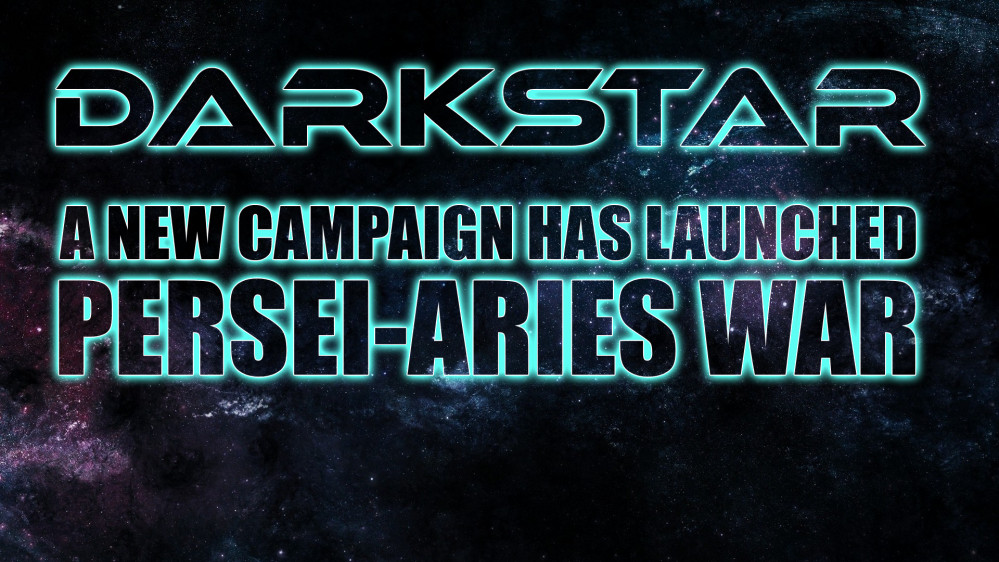
Persei-Aries War Resumes
Long-Range American Raid at 14 Hercules (Khaizan's Haven)
FROM: UNITED NATIONS REGIONAL COLONIAL CENTER
09:10 SOL GMT, 23 AUGUST 2521
BREAKAUTH: 181072.18J
CLEARANCE: SECRET (NATIONAL)
**UNITED NATIONS COMMUNIQUE**
The general American offensive continues to unfold across the Hercules Rim, a clear indication of their desire to bring their participation in the Third Hercules War to a decisive and successful conclusion. Almost simultaneously with the successful raid they and their Russian allies have carried off at the HH779 comet in the Outer Hebrides (Mu Hercules A/B), other elements of Task Force Oriskany have sortied from Port Halsey and made the incredible 60 light-years to Khaizan’s Haven in just two over weeks.* Their mission is to hit the Arab League’s surveillance outpost and naval staging platform orbiting Bayankhongor,
*[In game terms, all the ships in Task Force Oriskany have purchased sufficient FTL upgrades until they can generate 12-magnitude Darkstar waves, giving them approximately x1000 c superluminal speeds.]
Bayankhongor is something of an oddity, a terrestrial planet in an irregular orbit, highly eccentric to the solar plane and much further from the 14 Hercules parent star than is found in most standard solar system models. Some speculate it is actually an escaped moon from one of the systems outer ice giants, others guess Bayankhongor was tossed out of its original orbit by migrating gas giants in the system’s early history. Bayankhongor is also a Mongol name, a vestige of 14 Hercules’ previous Black Dragon occupants (the League hasn’t yet given the rogue planet a new Arabic name).
The purpose of the American raid may seem unclear until one reviews the over situation in the Third Hercules War. Obviously the American effort is focused against the British along the spinward shoulder of the Hercules Rim. But while the Americans have their hands full in places like the Outer Hebrides, the last thing they want are Japanese or Arab League allies showing up to help the British. So the Bayankhongor Raid is meant to pin down other Renkei Alliance forces on the coreward shoulder of the Hercules Rim, demonstrating that Japanese and League holdings out here remain under threat, and discourage redeployments to help the British at the Outer Hebrides.
As for the League, their mission is much less circumspect. With these repeated incursions by the Russians and now the Americans, the League remains determined to defend these new holdings at 14 Hercules. “Stay out of Khaizan’s Haven,” one League commenter was heard to say. “This is our system, we stole it from the Black Dragons fair and square!”
United States: Oriskany
Arab League: Muakhah
212 points per side
RAID victory rules
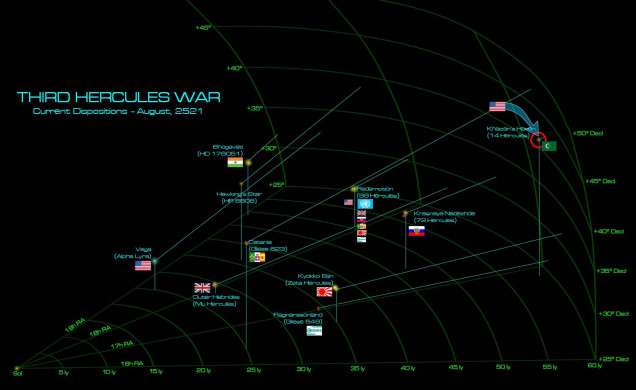 The current disposition of the Third Hercules War. With successful American and Russian raids putting the British on the back foot in the Outer Hebrides (Mu Hercules A/B), the Americans hope this raid way out at 14 Hercules will give pause to British allies in the Renkei Alliance (Japanese and Arab League). The Americans hope that raiding operations along the coreward shoulder of the Hercules Rim will discourage Japanese or Arab redeployments of naval reinforcements to help the British at the Outer Hebrides, thereby putting Japanese and League possessions at greater risk.
The current disposition of the Third Hercules War. With successful American and Russian raids putting the British on the back foot in the Outer Hebrides (Mu Hercules A/B), the Americans hope this raid way out at 14 Hercules will give pause to British allies in the Renkei Alliance (Japanese and Arab League). The Americans hope that raiding operations along the coreward shoulder of the Hercules Rim will discourage Japanese or Arab redeployments of naval reinforcements to help the British at the Outer Hebrides, thereby putting Japanese and League possessions at greater risk. 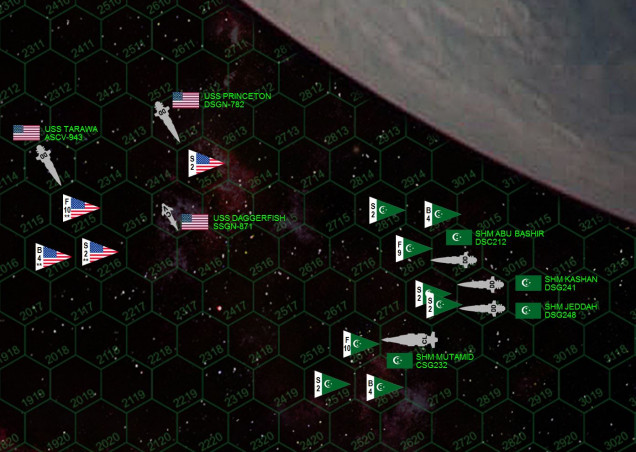 Here is the matchup. This is a small one, and the second Darkstar game played that day. American forces include the destroyer USS Princeton (sister ship to Oriskany but with fewer upgrades), light carrier USS Tarawa (a converted USMC planetary assault ship), and the hunter-killer torpedo corvette USS Daggerfish. These ships all generate 12-mag Darkstar waves (have earned and purchased the required upgrades) which explains how they crossed the Hercules Rim to hit such a remote target so quickly. The Tarawa carries the fighters and bombers of USMC aerospace strike squadron VMF/A-319 (the “Tigersharks”), double-elite badasses who are nevertheless badly outnumbered by the aerospace strike wings of both the SHM Matamid (Almanzor class light hybrid cruiser) and SHM Abu Bashir (Khalifa class light carrier). Escorting the League carrier and hybrid cruiser are the sisterships SHM Jeddah and Kashan (Basra class destroyers). In all, the Americans are heavily outnumbered. In terms of gunnery we’re looking at a light cruiser and two destroyers against just a destroyer … in terms of aerospace we’re looking at a 2:1 superiority. But these American ships are elite, and the USS Daggerfish carries insanely dangerous torpedoes guided by a +2 CiC/targeting bonus and +2 (double upgraded) electronic warfare. In total this gives her forward spread (8 tubes) +4 to hit, and League mass drivers a -2 to shoot them down. Ouch.
Here is the matchup. This is a small one, and the second Darkstar game played that day. American forces include the destroyer USS Princeton (sister ship to Oriskany but with fewer upgrades), light carrier USS Tarawa (a converted USMC planetary assault ship), and the hunter-killer torpedo corvette USS Daggerfish. These ships all generate 12-mag Darkstar waves (have earned and purchased the required upgrades) which explains how they crossed the Hercules Rim to hit such a remote target so quickly. The Tarawa carries the fighters and bombers of USMC aerospace strike squadron VMF/A-319 (the “Tigersharks”), double-elite badasses who are nevertheless badly outnumbered by the aerospace strike wings of both the SHM Matamid (Almanzor class light hybrid cruiser) and SHM Abu Bashir (Khalifa class light carrier). Escorting the League carrier and hybrid cruiser are the sisterships SHM Jeddah and Kashan (Basra class destroyers). In all, the Americans are heavily outnumbered. In terms of gunnery we’re looking at a light cruiser and two destroyers against just a destroyer … in terms of aerospace we’re looking at a 2:1 superiority. But these American ships are elite, and the USS Daggerfish carries insanely dangerous torpedoes guided by a +2 CiC/targeting bonus and +2 (double upgraded) electronic warfare. In total this gives her forward spread (8 tubes) +4 to hit, and League mass drivers a -2 to shoot them down. Ouch. 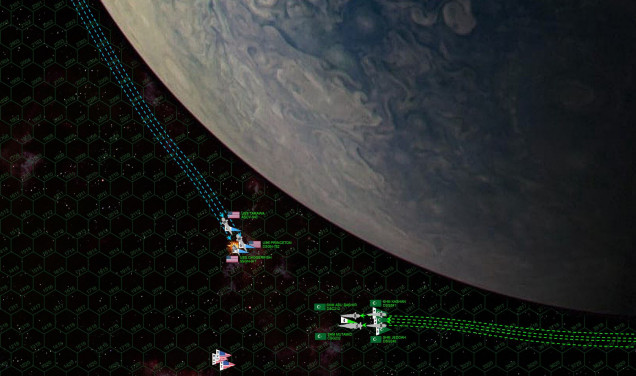 The Americans and League make their initial approach. Almost immediately I see the mistake by sleep deprived mid may have made here … eager to show off how fast this small battlegroup was, I closed with the Arab League WAY too fast, thus throwing away much of my advantage in electronics, elite aerospace, and ranged accuracy. Closing this quickly gives my opponent Muakhah the chance to make this about GUNNERY, a prospect in which his battlegroup will win ten times out of ten. As if to prove the point, he focuses his forward lasers and EPCs on the USS Daggerfish. While her shielding and electronic warfare make her about as hard to hit as a cloaked Romulan Bird of Prey, the League ships have a fair amount of electronics as well, and when it comes to gunnery salvoes at this range … numbers matter. The Daggerfish is soon crippled with hits to both her bridge and starboard reactor. While losing the ship is bad enough, losing the eight Mark 48 torpedoes (quadruple upgraded, by the way) really takes the killing edge off the ONE BIG AEROSPACE STRIKE I’m going to be launching … my only real chance at victory. This was a dumb move on my part, but my opponent saw it and took advantage, smart enough to NOT waste his first big salvo on the more obvious targets like USS Princeton.
The Americans and League make their initial approach. Almost immediately I see the mistake by sleep deprived mid may have made here … eager to show off how fast this small battlegroup was, I closed with the Arab League WAY too fast, thus throwing away much of my advantage in electronics, elite aerospace, and ranged accuracy. Closing this quickly gives my opponent Muakhah the chance to make this about GUNNERY, a prospect in which his battlegroup will win ten times out of ten. As if to prove the point, he focuses his forward lasers and EPCs on the USS Daggerfish. While her shielding and electronic warfare make her about as hard to hit as a cloaked Romulan Bird of Prey, the League ships have a fair amount of electronics as well, and when it comes to gunnery salvoes at this range … numbers matter. The Daggerfish is soon crippled with hits to both her bridge and starboard reactor. While losing the ship is bad enough, losing the eight Mark 48 torpedoes (quadruple upgraded, by the way) really takes the killing edge off the ONE BIG AEROSPACE STRIKE I’m going to be launching … my only real chance at victory. This was a dumb move on my part, but my opponent saw it and took advantage, smart enough to NOT waste his first big salvo on the more obvious targets like USS Princeton.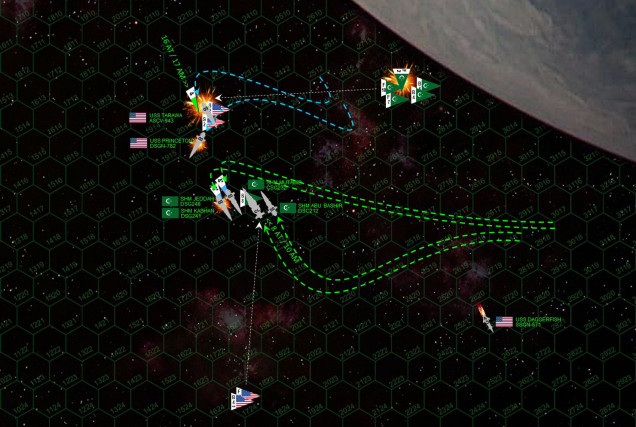 Things continue to go badly for the Americans as … sure enough … their aerospace and torpedo strike doesn’t come to very much. Sure, the League is helped by some good dice rolls on point defense (a 6 and two 5s, if memory serves) but in a game like Darkstar, players make their own luck, which Muakhah did LAST turn by knocking out the Daggerfish. If I’d still had those EIGHT Class 4 torpedoes, with +4 to hit and -2 to shoot down, good mass driver rolls wouldn’t have mattered, this torpedo and aerospace strike would’ve still blown Abu Bashir out of the stars. Also, I divided by aerospace strike here (perhaps not realizing just how bad it had been weakened), so while I damage Abu Bashir and Kashan, I don’t cripple either ship. Meanwhile, while I’m able to shoot down some of the “Mylekinir” (Fire Angel) fighters slinging missiles at USS Tarawa, I don’t shoot down enough of the torpedoes released by his “Demkikham” (Vengeance) bombers, and the Tarawa takes enough hits in her engines and reactors to leave her adrift, burning, and without power.
Things continue to go badly for the Americans as … sure enough … their aerospace and torpedo strike doesn’t come to very much. Sure, the League is helped by some good dice rolls on point defense (a 6 and two 5s, if memory serves) but in a game like Darkstar, players make their own luck, which Muakhah did LAST turn by knocking out the Daggerfish. If I’d still had those EIGHT Class 4 torpedoes, with +4 to hit and -2 to shoot down, good mass driver rolls wouldn’t have mattered, this torpedo and aerospace strike would’ve still blown Abu Bashir out of the stars. Also, I divided by aerospace strike here (perhaps not realizing just how bad it had been weakened), so while I damage Abu Bashir and Kashan, I don’t cripple either ship. Meanwhile, while I’m able to shoot down some of the “Mylekinir” (Fire Angel) fighters slinging missiles at USS Tarawa, I don’t shoot down enough of the torpedoes released by his “Demkikham” (Vengeance) bombers, and the Tarawa takes enough hits in her engines and reactors to leave her adrift, burning, and without power. 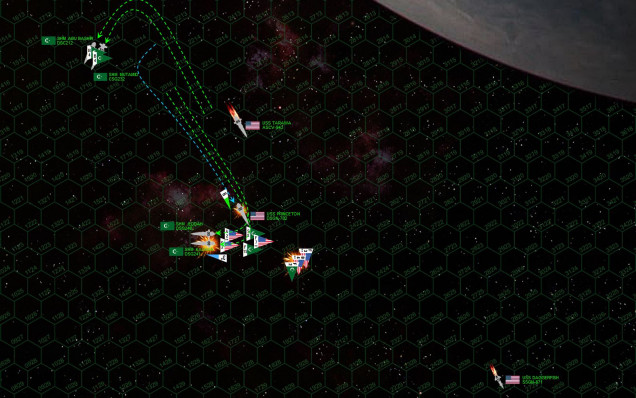 While the Americans have clearly lost this game, it’s up to the USS Princeton and Marine pilots of VMF/A-319 to at least mitigate this disaster down to a “minor” defeat. Note the League has somewhat divided their battlegroup here, a result of basically always losing initiative to these much faster American ships and so trying to cover multiple angles in their movement phase. While this isn’t a bad move (again, it’s all but impossible for Muakhah’s ships to beat Princeton on initiative) it does leave the damaged destroyer Kashan in somewhat isolated and vulnerable to a second strike. The Marines of “Tigershark” squadron dive for her damaged stern, taking heavily losses to League mass driver defenses. But the FS/A-81 Avenger bombers, E/S-101 Hawkeye scouts, and especially F/S-44 Star Corsair fighters put enough chain guns into the stern of the Kashan to detonate her starboard engines and reactors, sending her hulk spinning through space. The Princeton has matched this move, meanwhile, and comes THAT CLOSE to crippling the SHM Jeddah as well with a point-blank broadside across her stern (literally I needed a 5+ to cripple, I rolled a 4).
While the Americans have clearly lost this game, it’s up to the USS Princeton and Marine pilots of VMF/A-319 to at least mitigate this disaster down to a “minor” defeat. Note the League has somewhat divided their battlegroup here, a result of basically always losing initiative to these much faster American ships and so trying to cover multiple angles in their movement phase. While this isn’t a bad move (again, it’s all but impossible for Muakhah’s ships to beat Princeton on initiative) it does leave the damaged destroyer Kashan in somewhat isolated and vulnerable to a second strike. The Marines of “Tigershark” squadron dive for her damaged stern, taking heavily losses to League mass driver defenses. But the FS/A-81 Avenger bombers, E/S-101 Hawkeye scouts, and especially F/S-44 Star Corsair fighters put enough chain guns into the stern of the Kashan to detonate her starboard engines and reactors, sending her hulk spinning through space. The Princeton has matched this move, meanwhile, and comes THAT CLOSE to crippling the SHM Jeddah as well with a point-blank broadside across her stern (literally I needed a 5+ to cripple, I rolled a 4). 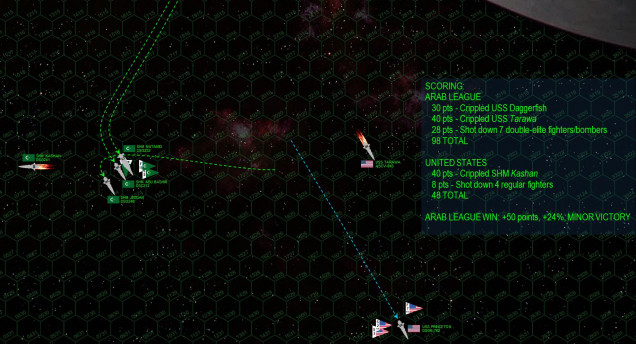 USS Princeton takes her damage as well, but manages to maintain power and leave the table on her own power. The American aerospace withdraws as well, and both side begin recovery and rescue operations. In particular, the fires aboard SHM Kashan continue to rage out of control despite controlled venting … it’s up to the flagship SHM Mutamid and her commander, Captain Rashid al-Maghrebi, to transfer additional damage control parties and take the Kashan in tow. It bears noting that IF the Americans had managed to cripple both the Kashan and Jeddah, and take less aerospace losses in that last-ditch strafing run, MAYBE they could have forced a draw out of this debacle. But as it stands, with only the Kashan left inoperable, the result is a solid League “minor” victory.
USS Princeton takes her damage as well, but manages to maintain power and leave the table on her own power. The American aerospace withdraws as well, and both side begin recovery and rescue operations. In particular, the fires aboard SHM Kashan continue to rage out of control despite controlled venting … it’s up to the flagship SHM Mutamid and her commander, Captain Rashid al-Maghrebi, to transfer additional damage control parties and take the Kashan in tow. It bears noting that IF the Americans had managed to cripple both the Kashan and Jeddah, and take less aerospace losses in that last-ditch strafing run, MAYBE they could have forced a draw out of this debacle. But as it stands, with only the Kashan left inoperable, the result is a solid League “minor” victory.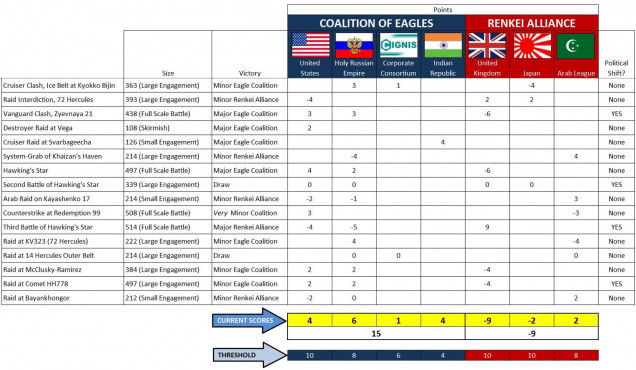 Needless to say, the result at Bayankhongor has taken some of the sting out of the American sector-wide offensive. While the operational result of this raid has little bearing on the situation at Outer Hebrides, the fact that American wolfpacks WON’T be prowling around the coreward systems of the Hercules Rim means that Japanese and Arab League reinforcements might be free to help the British after all. Furthermore, half of Task Force Oriskany is now limping back across the Hercules Rim, with ships facing long drydock repair times once they return. These are ships that will be sorely missed when the Americans open the next phase of their operations in the Outer Hebrides.
Needless to say, the result at Bayankhongor has taken some of the sting out of the American sector-wide offensive. While the operational result of this raid has little bearing on the situation at Outer Hebrides, the fact that American wolfpacks WON’T be prowling around the coreward systems of the Hercules Rim means that Japanese and Arab League reinforcements might be free to help the British after all. Furthermore, half of Task Force Oriskany is now limping back across the Hercules Rim, with ships facing long drydock repair times once they return. These are ships that will be sorely missed when the Americans open the next phase of their operations in the Outer Hebrides.









































































I like playing against Oriskany after he has used up most of his tactical genius and luck against Damon. Gives me a chance for victory!
Thanks, @muakhah – @damon really did face the best I had to offer, not only in detailed play, but the best ships (USS Oriskany, USS Liberty, CPK Admiral Lazarev, CPK Syekyra, Dead Rabbits, Eight Ball Express, etc.). Then again, you were up against Task Force Oriskany ships as well. USS Princeton is NO slouch, and USS Daggerfish is a freakin’ DEADLY li’l bitch when handled more competently than I did in this game. I think I woke up a little in the later turns, using assets like VMF/A-391 “Tigersharks” a little better to at least even the score up a… Read more »
Thanks Oriskany, hopefully this will mean the Arab league can regain its momentum and go on the offensive again!